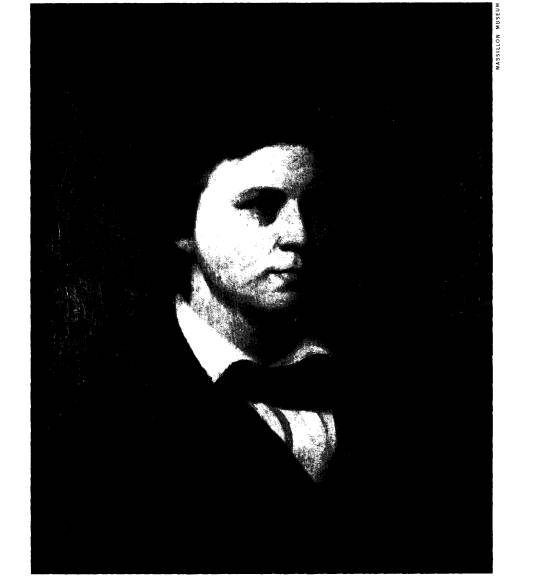Ohio History Journal
|
COLLECTIONS AND EXHIBITS |
|
|
|
THE CIVIL WAR LITHOGRAPHS OF ALFRED EDWARD MATHEWS by ELIZABETH R. MARTIN |
|
THE CIVIL
WAR lithographs of the Ohioan Alfred Edward Mathews in the Ohio His- torical Society collections are representa- tive of the contribution made by the soldier artist to the pictorial record of the Civil War. No war before or since has been so fully portrayed by amateurs and professionals in the art media of its time--oil, water color, lithograph, wood engraving, etching, pencil sketch, and, lastly, photography, which was then in its promising youth. The work of many soldier artists who sketched in letters, diaries, and notebooks with pen and pencil is unrecorded. A fine example of such work is in the Society's library in the pen and ink sketches illustrating the manuscript reminiscences of Henry O. Dwight of the Twentieth Ohio Volunteer Infantry. A few soldier artists, such as Alfred E. Mathews and another Ohioan, Albert Ruger, sold their sketches to litho- graphing firms. However, their profes- sion at the time was soldiery and not art, and their work represents the ama- teur's role rather than the professional's in the pictorial record of the war. The greatest contribution to the pic- torial record of the war was made by the professional war artists of the illus- trated weekly news magazines, Frank Leslie's Illustrated Weekly Newspaper, Harper's Weekly, the New York Illus- trated News, and
the oldest of the popular weekly magazines, the Illustrated London News, which
alone recorded the southern war effort. The war artists, or "special artists" as they were frequently called, accompanied the armies and made on- the-spot sketches of camp life and military engagements.
They dispatched their |
|
sketches home to their magazines, where one or several staff artists reproduced them on wood block. The roster of spe- cial artists includes William T. Crane, Frank H. Schell, William Waud, and Ed- win Forbes of Leslie's. Forbes in 1876 published his sketches under his own imprint in a series of forty copper-plate etchings, Life Studies of the Great Army, a copy of which is in the Society's library. Alfred R. Waud, one of the greatest of the war artists, served both Harper's and the New York Illustrated News at differ- ent periods. The American painter Win- slow Homer of Harper's staff served briefly as a war artist, and later developed many of his sketches in oil and water- color paintings. Frank Vizetelly was the war artist of the Illustrated London News, which carried the pictorial record of the Confederate effort. Others who contributed to the visual record of the war were the photographers, who with the war artists followed the armies. In contrast to the war artists, who had in wood engraving and lithog- raphy quick and inexpensive media for the reproduction of their sketches, the photographers were burdened with heavy equipment, a wet-plate process, a long exposure period, and no means to repro- duce their product cheaply. For these rea- sons their photographic record did not reach the public until the closing year of the war, when Harper's carried wood engravings of Brady photographs. Al- though the photographs of Mathew B. Brady and others present an important still-picture documentary of posed gen- erals and soldiers, buildings and equip- ment, they lack the action and eyewitness character of the war artists' and soldier artists' sketches. Alfred E. Mathews was a soldier artist who, unlike Henry O. Dwight, sketched with a purpose, which was to sell his sketches. Although two of his sketches |
|
232 OHIO HISTORY |
|
appeared in Harper's Weekly, November 23, 1861, this market undoubtedly be- came closed to him as the weeklies de- veloped their own staffs of war artists. Mathews then turned to lithography, which had been the popular, cheap art form since the 1840's. It is interesting to note that Mathews' forty known litho- graphic views of the war total almost half the output of the famous "Print- makers to the People," Currier and Ives, who made eighty-four lithographs re- lated to the Civil War. The poorly drawn Currier and Ives battle scenes depict grotesque
thick-necked generals and stunted soldiers in static poses and to- tally lack the documentary value of Math- ews' lithographs. Mathews' sketches were lithographed by three Cincinnati firms, of which Middleton, Strobridge and Company made all but seven. This company is well known for its lithograph of the "Funeral Obsequies of the Late Pres't A. Lincoln" and for the Ohio State Board of Agri- culture certificate which was designed by Thomas Sully. Of the other Cincinnati firms, Ehrgott, Forbriger and Company made four of Mathews' lithographs, and the Donaldson and Elmes Company made three, which appear to be the total output of this firm. A list of Mathews' litho- graphs in Robert Taft's Artists and Illus- trators of the Old West, 1850-1900 (1953), compiled from the combined holdings of the Library of Congress and the Denver Public Library, records thirty-seven different views, or thirty-eight if a variant in print size is considered. In the Society's collection of thirty-five different views are three which are not listed in Taft, bringing the total known views of Mathews' lithographs to forty. (A short-title list of Mathews' lithographs in the Society's collection is given at the end of this article.) Mathews sketched the war from a com- |
|
batant's viewpoint. He saw the line-up of troops opposing each other across a field; the emplacement of batteries, cotton bales, rifle pits; soldiers on the march and in battle. His sketches are pictorial state- ments of regimental maneuvers, bivouacs, and materiel, and they lack the emotional impact which Alfred R. Waud, Edwin Forbes, Winslow Homer, and others achieved in their sketches. However, Mathews' detailed documentation of regi- mental units, equipment, and terrain is of historical and documentary interest and must have had strong appeal to the regi- mental loyalties of many participants and their families. Several of his sketches were lithographed with variations in de- tail and legend to represent different military units, and were doubtlessly de- signed by the artist or the lithographer to widen their sales appeal. Twenty of Mathews' sketches appear in Battles and Leaders of the Civil War, published by the Century Company in 1887-88 and 1894, many of which bear the name of the Century staff artist who adapted them for reproduction. Although Mathews is given credit in the table of contents of each volume with the phrase "after lithograph of war-time sketch by A. E. Mathews," he is not included in the listing of the artists. It may be said that the Century staff artists faithfully repro- duced Mathews' sketches, though now and then making minor changes. In the Century Company reproduction of one of Mathews' sketches of "The Siege of Vicksburg," a general in the foreground has his right arm raised instead of his left as in the original Mathews sketch, and to this sketch the Century artist boldly added his initials, E.J.M.! Mathews was born in Bristol, England, in 1831, one of seven children of Joseph Mathews, a book publisher, who in 1833 brought his musically and artistically talented family to live in Rochester, Ohio. |
|
COLLECTIONS AND EXHIBITS 233 |
|
A biographical account of Mathews' life and works is given in Taft. Taft drew on a manuscript biography of Mathews pre- pared by a brother and upon other Mathews materials in the Denver Public Library's Western Collection, which has a substantial collection of his Civil War lithographs, as well as an outstanding collection of his western lithographs, which established Mathews as one of the foremost pictorial artists of that region. Little is known of Mathews' boyhood in Ohio other than that he learned the trade of typesetter on the New Philadel- phia Ohio Democrat, which was edited by his brother Charles. Another brother, William T. Mathews, was a
portrait painter of presidents--Lincoln, Hayes, Garfield, and McKinley--and is listed in several "Who's Who's" of American ar- tists, while his brother Alfred is not. Another brother was a physician. At twenty-five Mathews was an itinerant bookseller and artist, selling books and sketches in Maine, Vermont, and New Hampshire. When the Civil War broke out, Math- ews was teaching school in Alabama. He described his escape from the South in a dramatic thirty-five page pamphlet, published in 1861 in New Philadelphia, Ohio, which is in the Society's collections. It bears this imposing descriptive title: Interesting Narrative; Being a Journal of the Flight of Alfred E. Mathews, of Stark Co., Ohio, from the State of Texas, on the 20th of April, and His Arrival at Chicago on the 28th of May, after Tra- versing on Foot and Alone a Distance of Over 800 Miles Across the States of Louisiana, Arkansas and Missouri, by the Most Unfrequented Routes; Together with Interesting Descriptions of Men and Things; of What He Saw and Heard; Appearance of the Country, Habits of the People, &c., &c., &c. In September 1861 Mathews enlisted in the Thirty-First Ohio Volunteer In- |
|
fantry, serving with Company E, and later with Company I. Prior to his en- listment in the Thirty-First he had served two months with Cotter's Independent Battery Light Artillery until it disbanded in September 1861. Some biographical data suggests that he did military maps during his service, as well as his on-the- spot sketches for the lithographs. The Thirty-First Ohio Volunteer In- fantry was mustered in at Camp Chase and left Columbus at the end of Septem- ber 1861 for Louisville, where it was stationed for over two months at Camp Dick Robinson. Mathews' earliest sketch is of a camp religious service, "Rev. L. F. Drake, Chaplain 31st Ohio Volunteers, Preaching at Camp Dick Robinson, Ky., November 10th 1861." This view, which shows several ladies seated in buggies and a gentleman in a top hat in attend- ance at the military service on a bleak, wintry-looking day, presents a relaxed social aspect of the war. The Thirty-First left Camp Dick Robinson in the middle of December for Somerset, Kentucky, and then in January they were dispatched to the assistance of General George H. Thomas of the Army of the Ohio at Mill Springs, but arrived too late to participate in the engagement, which Mathews pic- torialized in a sketch, "The Battle of Logan's Cross Roads, Fought on the 19th of January, 1862." This view shows the death of the Confederate General F. K. Zollicoffer and identifies the "Secession forces," the Union forces, and General Thomas L. Crittenden's staff. Another sketch pertaining to this battle, "Union Forces Crossing Fishing Creek," a tribu- tary of the Cumberland, shows the troops of the Seventeenth, Thirty-First, Thirty- Fifth, and Thirty-Eighth Ohio Volunteer Infantry and Captain Hewett's Kentucky Battery, commanded by General Albin Schoepf, being guided across Fishing Creek with a rope, en route to attack the |
|
234 OHIO HISTORY |
|
rebels under Crittenden and Zollicoffer. The picture is worthy of Grandma Moses for its minutiae of detail. Mathews' lithograph of "The Battle of Wild Cat, Oct. 21st, 1861," is identified as "Sketched on the Spot." Although the Thirty-First Ohio was at Camp Dick Rob- inson at this time, it may be presumed that Mathews viewed some of the skir- mishes there, as the Wild Cat region was only sixty miles southeast of Camp Dick Robinson. The military engagements at Wild Cat and Logan's Cross Roads suc- ceeded in driving the Confederates out of the Cumberland Gap and opened up a path for the Union forces into eastern Tennessee. Early in March the Thirty-First arrived in Nashville, Tennessee. (The writer is indebted to Mr. R. M. Tangeman of Columbus for his map of the route of the Thirty-First Ohio Volunteer Infan- try.) Here Mathews made two sketches, "Female Seminary, Nashville, Tenn[.], Barracks of the 51st Regt. O.V." and "The First Union Dress Parade in Nash- ville." The latter presents another leisurely view of the war, showing a delegation of top-hatted gentlemen in the foreground and groups of ladies viewing the parade from the balconies of buildings in the background. Later in March the Thirty- First left Nashville for Savannah, Tennes- see, in the southwest theater of the war, where they engaged in the first great battle of the war--the battle of Shiloh, April 6-7, 1862. Mathews made five sketches related to this battle, two of which are of Pittsburg Landing on the Tennessee River. One sketch, "Battle of Shiloh. The Gunboats Tylor and Lex- ington Supporting the National Troops, by Firing up the Ravine back of Pitts- burg Landing," shows two side-wheeler steamers converted by wooden planks into warships. The lithograph "Pittsburg Landing" represents General Don Carlos |
|
Buell's troops arriving by steamboat from the east bank of the Tennessee River in twelve river packets to reinforce General Ulysses S. Grant's troops, who with the aid of the gunboats repulsed General Albert Sidney Johnston's attack at Pitts- burg Landing, or Shiloh, in what has been described as one of the most savage engagements of the war. Other sketches of the battle of Shiloh include "The Battle of Shiloh. Charge and Taking of a New Orleans Battery by the 14th Regt. Wisconsin Volunteers[,] Monday, April 7, 1862" and two small ones, "Shiloh Church" and "Shiloh Spring." In the latter sketch a soldier on horseback has a sketch pad or map board tucked under his left arm. Per- haps in this view Mathews sketched himself. The battle of Shiloh forced the Con- federate army to withdraw to Corinth, Mississippi, and by the end of April the Thirty-First Ohio was moving with Union forces toward Corinth. There is great similarity between the view "On the March from Hamburg to Camp Before Corinth," in which soldiers of a number of Indiana, Illinois, Iowa, Minnesota, Michigan, Missouri, and Ohio regiments are shown fording a creek with supply wagons, and the view of "The 48th Regt. Ind. Vol., on the March from Hamburgh to Camp Before Corinth, April, 29th 1.862." This is one of several examples of either the lithographer's or the artist's intention to broaden the potential market for a lithograph by varying the design only slightly, or reproducing it exactly, and then changing the legend to show other regiments. The lithograph "Hos- pital Varian, Hamburg, Tenn." is a hand- some scenic view of rows of hospital tents in a stylized forest and several wounded soldiers in the foreground. This view too may have had strong home appeal, as 3,500 sick and wounded were reported |
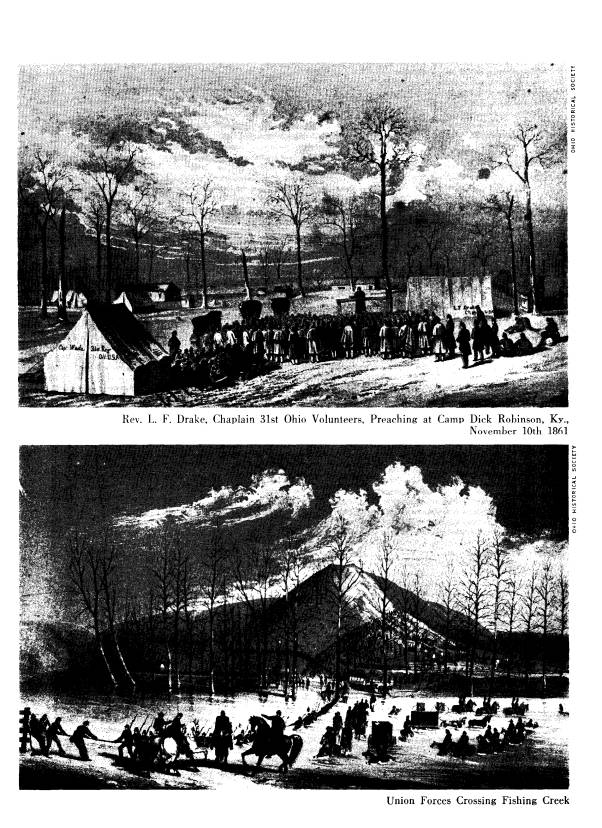
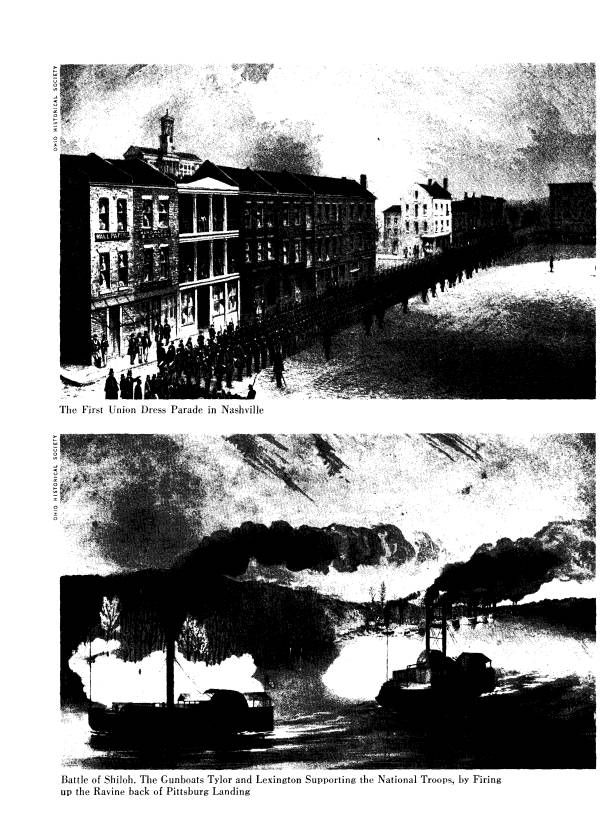
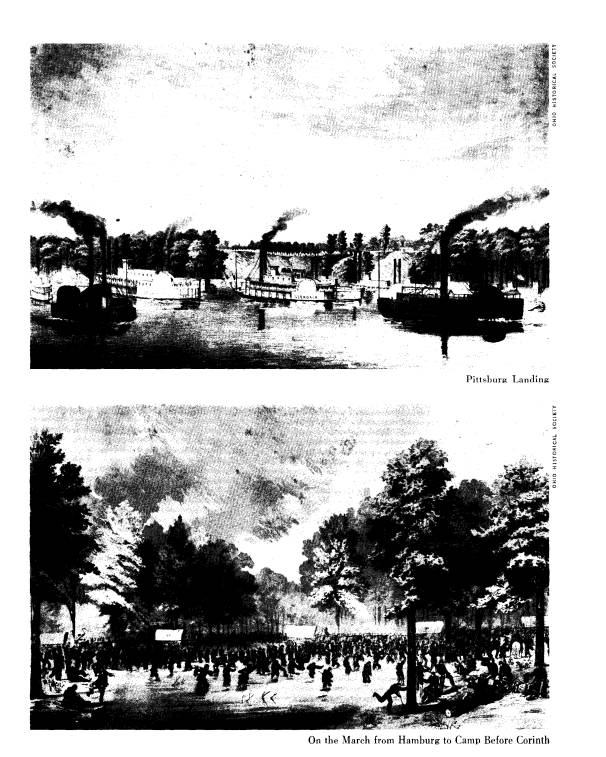
|
238 OHIO HISTORY |
|
to be in the Hamburg sick camp follow- ing the battle of Shiloh. However, the sketch has a mood of comfort and quiet rather than confusion and tragedy, which one might expect in an overcrowded sick camp. The siege of Corinth, April 29- May 30, is recorded in two of Mathews' lithographs: "Encampment of Gen. Pope's Army Before Corinth. May, 1862" and "The 31st Regt. Ohio Vol., (Col. M. B. Walker.) Building Breastworks and Em- brasures Before Corinth, Miss., May, 1862." On May 30, Union forces occu- pied Corinth and forced a Confederate retreat. The Thirty-First moved to Hunts- ville, Tennessee, then to Decherd, guard- ing mountain passes until General Brax- ton Bragg's campaign into Kentucky opened. In September or later Mathews sketched the defensive action near Cincinnati against the anticipated attack of General Kirby Smith in two lithographs, "The 100th Reg't Ohio Volunteers, in Line of Battle" and "The 103rd Reg't O.V., in Line of Battle at Fort Mitchell," showing the state of entrenchments in front of the fort on Thursday, September 11, 1862. Mathews' handsome view of "The 121st Reg't Ohio Volunteers, Crossing the Pon- toon Bridge at Cincinnati," dated Septem- ber 19, 1862, presents a fine view of the city's river front. A similar view, not in the Society's collection, is entitled "The 21st Reg't Wisconsin Vol., Crossing the Pontoon Bridge, at Cincinnati." It is dated September 13, 1862. In this view the sole difference is the turn of the gen- eral's head and the drawing of his head- gear. Early in October the Thirty-First saw the action but did not participate in the battle at Perryville on October 8, 1862, which Mathews sketched under the title "Battle of Perryville," showing the Con- federates confronting the Union forces of the Twenty-First Wisconsin across a |
|
field of corn. Mathews' lithograph notes that the Wisconsin regiment lost forty-one men killed and one hundred and one wounded. Following the engagement at Perryville, which was the last Confederate attempt to gain Kentucky, Buell was re- placed by the Ohioan, General William S. Rosecrans. From Perryville the Thirty- First Ohio Volunteers marched again to Nashville, joining Rosecrans' forces mov- ing southeast toward Murfreesboro, Ten- nessee, where they met Bragg's Confed- erate Army of Tennessee at the battle of Stone River, which lasted from Decem- ber 31, 1862, to January 3, 1863. Mathews made four different sketches of this battle, in which 3,685 Ohioans were killed, wounded, or reported missing out of 13,000 casualties inflicted by the Confederates, whose losses totaled over 10,000 men. Of this fiercely contested conflict, General Crittenden is quoted as saying that he did not think "two better armies, as numerous and so nearly matched in strength, ever met in battle." After Stone River the Union army ad- vanced southeast to Chattanooga. A mem- ber of the Thirty-First Ohio, S. A. Mc- Neil of Richwood, Ohio, in his Personal Recollections of Service in the Army of the Cumberland, wrote, "It was peach season when we started on the march up the valley and across the mountain ranges into the Chickamauga valley." The Thirty-First Ohio was engaged in the battle of Chickamauga, September 19-20, 1863, and in the siege of Chattanooga, September 24-November 23, 1863. In the lithograph "Lookout Mountain, near Chattanooga, Tenn.," Mathews has de- picted against the background of Lookout Mountain a wood-burning locomotive of the Nashville and Chattanooga Rail- road pulling boxcars filled with soldiers through a desolate battle area strewn with stumps and carcasses of dead mules. The lithograph bears the date 1864. On |
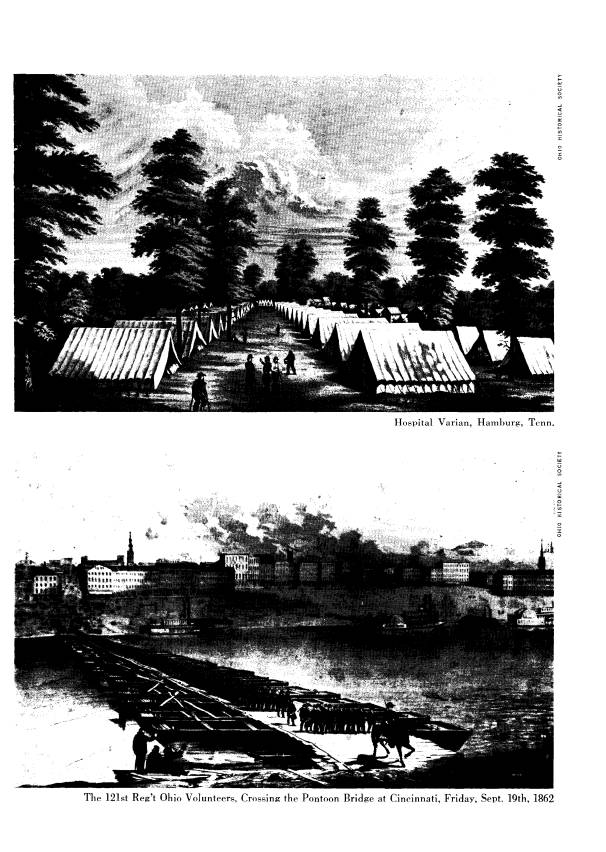
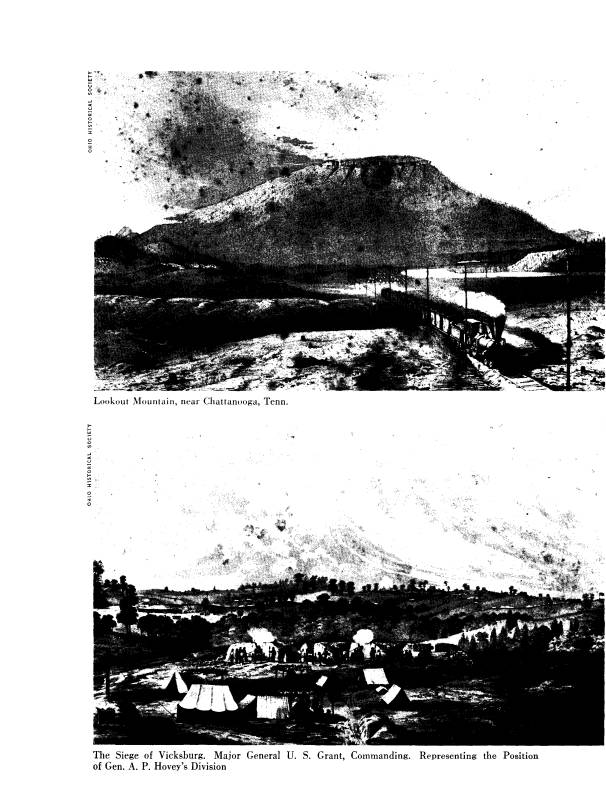
|
COLLECTIONS AND EXHIBITS 241 |
|
the lithograph "The Army of the Cumber- land in Front of Chattanooga" the legend identifies by numerals and letters bat- teries and divisions of Generals John M. Brannan, James S. Negley, and Lovell H. Rousseau of Major General George H. Thomas' army corps. Another sketch, "Chattanooga and the Battle Ground," identifies "The Eagle's Nest." The Thirty- First remained at Chattanooga for some time, and following reenlistment were given a thirty-day furlough, during which new recruits brought the regimental strength to about 800 men. By May the Thirty-First Ohio had started on Sherman's march to Atlanta and to the sea. Mathews, however, did not reach Savannah. His three-year en- listment was up in September, and he was mustered out on September 22, 1864. What Mathews did after that until the close of the war is not known. His regi- ment saw action in the campaigns of the Carolinas, before it was mustered out at Louisville, July 20, 1865. Mathews made four sketches of the siege of Vicksburg, May 22 - July 4, 1863. As the Thirty-First was not en- gaged at Vicksburg, it may be assumed that he went there on furlough or on military assignment, as the following two lithographs are copyrighted 1863: "The Siege of Vicksburg. Major General U. S. Grant, Commanding. Representing the Position of Maj. Gen. John A. Logan's Division of Maj. Gen. J. B. McPherson's Army Corps," and "The Siege of Vicks- burg, the Fight in the Crater of Fort Hill, After the Explosion, June 25[,] 63." Following the war Mathews exhibited at Kilgore Hall in Steubenville, Ohio, on January 18, 19, and 20, 1865, a pano- ramic canvas entitled "A. E. Mathews' Grand Topographical Work of Art," pre- senting the principal battles of the West-- Vicksburg, Stone River, Lookout Moun- tain, and Missionary Ridge-and also |
|
Sherman's campaign through Georgia. The Steubenville Daily Herald, January 19, 1865, described the panorama as a "large collection of historical paintings, occupying more than 5,000 feet of can- vas" which were "very accurate, elegant, instructive and meritorious." It is not known what happened to this panorama or to a similar panorama of the Rocky Mountain area, which Mathews exhibited in 1868 in the West. Regarding his Vicks- burg sketches, the Herald on January 20 carried a testimonial letter dated August 9, 1863, from General Grant to Private A. E. Mathews, in which Grant states: "Sir--I have examined the Lithographs of views taken by you of the 'Siege of Vicks- burg,' and do not hesitate to pronounce them among the most accurate and true to life I have ever seen. They reflect great credit upon you as a delineator of landscape views." In the spring of 1865 Mathews followed the westward migration to Nebraska, where he sketched four views of Nebraska City, and in November he was in Denver. His western lithographs are highly prized for their detailed obser- vations of life in the early West. He published his work in Pencil Sketches of Colorado (1866)
and Pencil Sketches of Montana (1868),
both exceedingly rare Western Americana, and in a lesser book, Gems of the Rocky Mountain Scenery (1869). With the exception of several business trips east, Mathews spent the years until his untimely death in 1874, at the age of forty-three, in the West. The Society's collection of thirty-five different views of Mathews' lithographs includes a group of twenty-nine which were identified by a typed label as "Pic- tures and Sketches of the Civil War. Presented to the Society by A. E. Mathews, 27 July 1928." As Mathews died in 1874 and no other A. E. Mathews has been identified with his family, the |
|
242 OHIO HISTORY |
|
source of this group remains a mystery. All of the twenty-nine are in excellent condition and have the wide, untrimmed margins prized by collectors, which leads to the speculation that these may have been the artist's copies pulled from the lithographer's stone. The other six views were gifts or purchases. It is believed that altogether they make the most com- plete single collection of Mathews' Civil War lithographs now extant. Thirty-two of the thirty-five views have been on exhibit at the Society's museum in Colum- bus since April of this year. A SHORT-TITLE LIST OF THE CIVIL WAR LITHO- GRAPHS OF ALFRED E. MATHEWS OWNED BY THE OHIO HISTORICAL SOCIETY (1) The Army of the Cumberland in Front of Chattanooga. (2) The Battle of Logan's Cross Roads. (3) Battle of Perryville. (4) The Battle of Shiloh. Charge and Taking of a New Orleans Battery by the 14th Regt. Wisconsin Volunteers [,] Monday, April 7, 1862. (5) Battle of Shiloh. The Gunboats Tylor and Lexington Supporting the National Troops, by Firing up the Ravine back of Pittsburg Landing. (6) The Battle of Stone River or Murfrees- boro'. Position of Col. Starkweather and Col. Scribner's Brigades on the 2d, 3rd and 4th of January, 1863. (7) The Battle of Stone River or Murfrees- boro'. Representing General Palmer's Division, and General Rousseau's Division, on the 31st of December, 1862. (8) The Battle of Stone River or Murfrees- boro'. Representing Gen. Sam Beatty's Brigade on the 31st of December, 1862. (9) The Battle of Wild Cat, Oct. 21st, 1861. [small view] (10) The Camp of the 31st Ohio Volunteers Shelled by the Troops Under Col. Basil Duke of Gen. Morgan's Command, Nov. 21st, 1862. (11) Camp Ready, Hamburg, Tennessee. |
|
(12) Chattanooga and the Battle Ground. (13) Encampment of Gen. Pope's Army Be- fore Corinth. May, 1862. (14) Farmington, Miss., May, 1862. (15) Female Seminary, Nashville, Tenn[.], Barracks of the 51st Regt. O.V. (16) The First Union Dress Parade in Nash- ville. (17) Fort Anderson. (18) Fort Mitchell. (19) The 48th Regt. Ind. Vol., on the March from Hamburgh to Camp Before Corinth, April, 29th 1862. (20) Hospital Varian, Hamburg, Tenn. (21) Lookout Mountain, near Chattanooga, Tenn. (22) On the March from Hamburg to Camp Before Corinth. (23) The 100th Reg't Ohio Volunteers, in Line of Battle. (24) The 103rd Reg't O.V., in Line of Battle at Fort Mitchell. (25) The 121st Reg't Ohio Volunteers, Cross- ing the Pontoon Bridge at Cincinnati, Friday, Sept. 19th, 1862. (26) Pittsburg Landing. (27) Rev. L. F. Drake, Chaplain 31st Ohio Volunteers, Preaching at Camp Dick Robinson, Ky., November 10th 1861. (28) Shiloh Church. (29) Shiloh Spring. (30) The Siege of Vicksburg, the Fight in the Crater of Fort Hill, After the Explosion, June 25[,] 63. (31) The Siege of Vicksburg. Major Gen. U. S. Grant, Commanding. Representing the Position of Gen. A. P. Hovey's Division. (32) The Siege of Vicksburg. Major General U. S. Grant, Commanding. Representing the Position of Maj. Gen. John A. Logan's Division of Maj. Gen. J. B. McPherson's Army Corps. (33) The Siege of Vicksburg. Major General U. S. Grant, Commanding. Representing the Position of the Seventh Division of Maj. Gen. J. B. McPherson's Army Corps. (34) The 31st Regt. Ohio Vol., (Col. M. B. Walker.) Building Breastworks and Embrasures Before Corinth, Miss., May, 1862. (35) Union Forces Crossing Fishing Creek. THE AUTHOR: Elizabeth
R. Martin is the head librarian of the Ohio Historical Society. |
